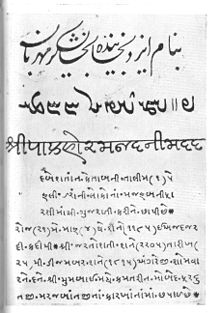Media in Gujarati language
| Part of a series on | |
|---|---|
| |
| Newspapers of India | |
| Category | |
| Newspapers by languages | |
| Related | |
| |
The Media in
Print media
History


1822—1915
The printing was introduced in Gujarati in 1812. The first printed book published was the Gujarati translation of


The
Several journal during those times were dedicated to social reform. Parhejhgar of Surat was devoted to prohibition. Lallubhai Raichand launched Shamasher Bahadur in Ahmedabad in 1854. Social reformer
The first daily published in Gujarat was Hitechchhu. It was launched a biweekly in 1861 and later became daily in 1873. Prajabandhu was introduced in 1895. A weekly from Kheda, Kheda Vartman was started in 1861 and completed its centenary. An evening newspaper Sanj Varman of Bombay was introduced in 1902 which published until 1950.[1] Doot, a Gujarati Catholic monthly, was launched from Bombay.
1915—1960
Gujarati journalism was greatly influenced by the

1960—2000
Following
2000 onwards
Sambhaav was the first media group to enter in online media in Gujarat.
Digital media
Gujarat was the first state in India where the rural high frequency television transmitter was established. In 1975, it was established at Pij, Kheda district. The state owned Doordarshan was the first to enter in television and it operates DD Girnar. Other privately operated TV channels are Colors Gujarati, P7 News, Dainik Gujarat, Gujarat First News, TV 9 Gujarati, Bizz News, VTV Gujarati, Sandesh News, GSTV News, ABP Asmita,[1][17] PTN News, Live Gujarati News.
Radio
The first radio station in Gujarat was founded by
Statistics
This section needs to be updated. (September 2017) |
In 1984, there were 735 publications in Gujarati including 43 dailies. It grew to 3005 publications in 2007—2008 as per
As per 2011, there were more than 4 million television connections in Gujarat.[1]
Further reading
- Kachot, Dr. Sanjay (2014). 19 Mi Sadinu Gujarati Patrakaratvana Pravaho ane Prabhav [Trends and Impact of Gujarati Journalism of 19th Century] (in Gujarati). RED'SHINE Publication. Inc. ISBN 978-93-84190-11-8.
- Kachot, Dr. Sanjay (2014). Gujarati Patrakaratvanu Sahityik ane Samajik Pradan [Literary and Social Contribution of Gujarati Journalism] (in Gujarati). RED'SHINE Publication. Inc. ISBN 978-93-84190-12-5.
See also
- Gujarati literature
- Gujarati language
- List of Gujarati-language writers
- List of Gujarati-language magazines
- Media of India
References
- ^ a b c d e f g h i j k l m Chatterjee, Mrinal (January 2013). "History of Gujarati journalism". Press Institute of India. Archived from the original on 13 October 2014. Retrieved 9 October 2014.
- ISBN 978-1-317-64216-9. Retrieved 5 August 2014.
- ^ ISBN 978-81-260-1194-0.
- ^ ISBN 978-81-8475-185-7.
- ISBN 978-0-9789517-0-2.
- ISBN 978-81-7201-006-5.
- ^ "Gandhi's journals: How the Mahatma shaped a nation's ideas through Young India, Navjivan and Harijan". Firstpost. Retrieved 2 October 2020.
- ^ "As Mahatma Gandhi turns 150, his news magazines Navjivan and Young India turn 100". The Print. Retrieved 29 September 2019.
- ^ ISBN 978-1-85743-254-1.
- ^ Smt. Hiralaxmi Navanitbhai Shah Dhanya Gurjari Kendra (2007). Gujarat. Gujarat Vishvakosh Trust. p. 457.
- Mansukhlal Maganlal Jhaveri (1978). History of Gujarati Literature. New Delhi: Sahitya Akademi. p. 153.
- ^ https://amritmahotsav.nic.in/unsung-heroes-detail.htm?15533
- ISBN 978-0-271-04349-4.
- ^ "Eminent Gujarati writer Bhupat Vadodaria passes away at 82". DNA. 5 October 2011. Retrieved 31 August 2014.
- ^ P.C.I. Review. 1986. p. 23.
- ^ Pravin N. Sheth; Ramesh Menon (1986). Caste and Communal Timebomb. Golwala Publications. pp. 81–82.
- ^ ISBN 978-0-07-008031-7.
- ^ Mukherji, Abhijeet (8 February 2008). "After ET Gujarati, BCCL all set to launch Hindi edition of Economic Times". Exchange4Media. Archived from the original on 14 October 2014.
- ^ "Times Group launches NavGujarat Samay". The Times of India. 17 January 2014. Retrieved 9 October 2014.
- Registrar of Newspapers for India. 2015. p. 25.

